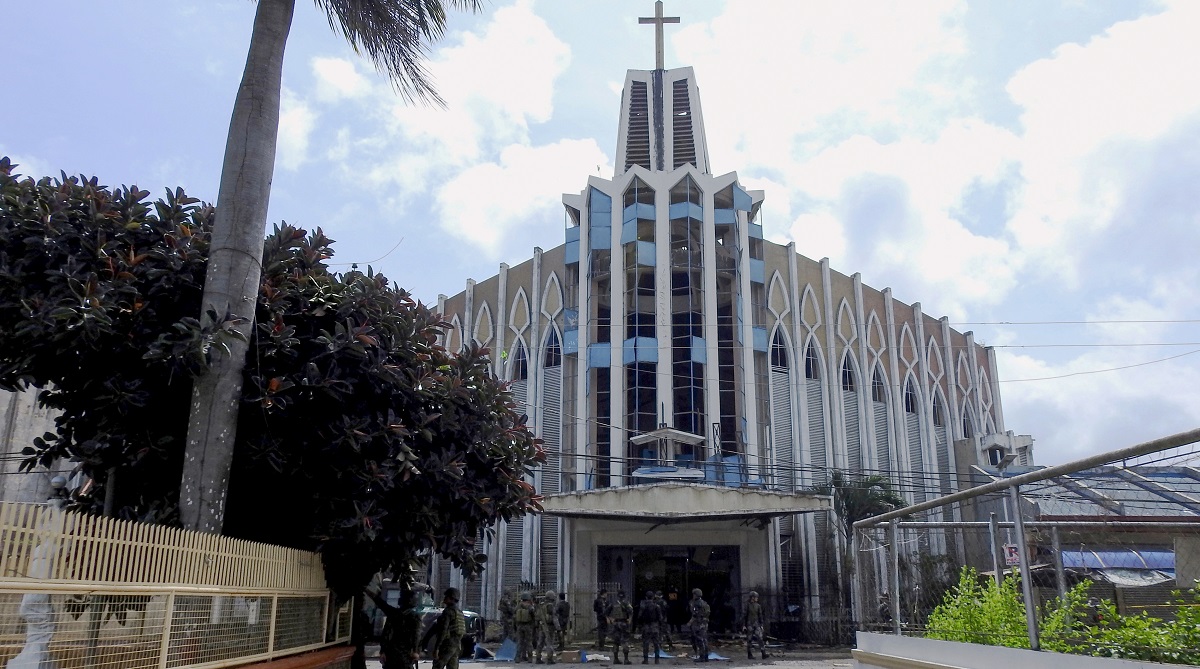Test of Philippines
In 1995, the Philippines had noticed strange Chinese military structures coming up on Mischief Reef in its Spratly Islands.
The armed forces of the Philippines will rise to the challenge and crush these godless criminals,” is the message of the presidential palace in Manila.

Policemen and soldiers are seen in front of a Catholic Church, where the bombing took place in Jolo, Sulu province on the southern island of Mindanao, southern Philippine on January 27. (Photo by NICKEE BUTLANGAN / AFP)
The conflict of religions has assumed hideous proportions. Islamist fundamentalists have struck in the predominantly Roman Catholic island of Jolo in the Philippines. Sunday’s twin attacks on a cathedral during Mass ~ killing no fewer than 20 people ~ happened in an area where Muslim militants are said to be active. Whether or not President Rodrigo Duterte has “weaponised the rule of law”, as claimed by his detractors, he has been remarkably prompt in mobilising the military to hunt down the attackers. “The enemies of the state have boldly challenged the capability of the government to secure the safety of the citizenry in that region. The armed forces of the Philippines will rise to the challenge and crush these godless criminals,” is the message of the presidential palace in Manila. The rumbling of tanks and the deaths among troops in the vicinity of the cathedral reaffirms the volatality of the communal question, which has not spared the devout even during the Sunday Mass. No group has as yet claimed responsibility, and this is seemingly in accord with the recent trend among the perpetrators to make confusion worse confounded. It is generally suspected, however, that the outrage was perpetrated by Abu Sayyaf, a militant group that has pledged allegiance to the Islamic State of Iraq and Syria and is notorious for its bombings and brutality. ISIS may not be in the vanguard following the offensive in Syria; it is pretty obvious that the Caliphate has been fielding its front units to carry out its mortal agenda in different parts of the world. Sunday’s mayhem can be contextualised with the blacklisting of Abu Sayyaf by the United States and the Philippines as a terrorist organisation because of bombings, kidnappings and beheadings. Its strategy is no different from that of ISIS, of a kind that has been executed in Bangladesh as well.
Direly significant is the timing of the outrage in Jolo. It has happened nearly a week after minority Muslims in the Roman Catholic nation had endorsed a new autonomous region in the southern Philippines, thus hoping to end nearly five decades of a separatist rebellion that has left no fewer than 150,000 people dead. Although most of the Muslim areas have approved the autonomy deal, voters in Sulu province, where Jolo is located, have rejected the arrangement. The province is home to a rival rebel faction that is opposed to the deal as well as smaller militant cells that are not part of any peace process. Unmistakable, therefore, is the lethal cocktail of spurious federalism and religion that has vitiated the Cathedral of Our Lady of Mount Carmel. The misgivings of the Western countries are not wholly unfounded. The possibility of ISIS-linked terrorists from the Middle East and South-east Asia forging an alliance with Filipino insurgents and turning the south into a breeding ground for extremists is dangerously real. It is a fearsome scenario beyond glitzy Manila.
Advertisement
Advertisement